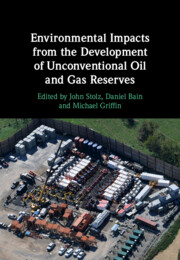Book contents
- Environmental Impacts from the Development of Unconventional Oil and Gas Reserves
- Environmental Impacts from the Development of Unconventional Oil and Gas Reserves
- Copyright page
- Contents
- Figures
- Tables
- Contributors
- Preface
- Part I Overview
- Part II Environmental Analysis
- 5 Air Quality
- 6 Methane and Climate Change
- 7 Water Usage and Management
- 8 Seismicity Induced by the Development of Unconventional Oil and Gas Resources
- 9 Naturally Occurring Radioactive Material (NORM)
- 10 Metal Isotope Signatures as Tracers for Unconventional Oil and Gas Fluids
- 11 Isotopes as Tracers of Atmospheric and Groundwater Methane Sources
- 12 The Microbiology of Shale Gas Extraction
- Part III Case Studies
- Index
- References
8 - Seismicity Induced by the Development of Unconventional Oil and Gas Resources
from Part II - Environmental Analysis
Published online by Cambridge University Press: 28 July 2022
- Environmental Impacts from the Development of Unconventional Oil and Gas Reserves
- Environmental Impacts from the Development of Unconventional Oil and Gas Reserves
- Copyright page
- Contents
- Figures
- Tables
- Contributors
- Preface
- Part I Overview
- Part II Environmental Analysis
- 5 Air Quality
- 6 Methane and Climate Change
- 7 Water Usage and Management
- 8 Seismicity Induced by the Development of Unconventional Oil and Gas Resources
- 9 Naturally Occurring Radioactive Material (NORM)
- 10 Metal Isotope Signatures as Tracers for Unconventional Oil and Gas Fluids
- 11 Isotopes as Tracers of Atmospheric and Groundwater Methane Sources
- 12 The Microbiology of Shale Gas Extraction
- Part III Case Studies
- Index
- References
Summary
Resource development in unconventional oil and gas plays is sometimes accompanied by unintended earthquakes, known as induced seismicity. To date, the largest such induced events have been the September 2016 5.8 MW Pawnee earthquake in Oklahoma, and the December 2018 5.2 MW earthquake in the Sichuan Basin. These earthquakes were triggered by different industrial processes, namely saltwater disposal (Pawnee) and hydraulic fracturing (Sichuan Basin). Current models indicate that such induced earthquakes occur by activation of a pre-existing fault system due to some combination of increased pore pressure, a change in fault-loading conditions arising from poroelastic effects, or precursory slow fault slip. This chapter provides a tutorial and review of basic underlying principles of induced seismicity and an overview of regulatory measures, along with several current research themes including tools for screening risk and forecasting maximum magnitude. These concepts are illustrated by case studies from the USA and western Canada.
Keywords
- Type
- Chapter
- Information
- Publisher: Cambridge University PressPrint publication year: 2022



